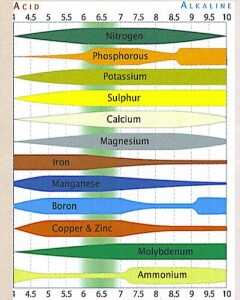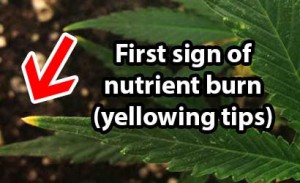
The marijuana pH of the nutrient solution controls the availability of ions that are needed to assimilate. In hydroponics, the marijuana pH level is normally in the range of 5.5 – 6.5 with 5.8 – 6.0 being ideal.
The pH of the nutrient solution in hydroponics needs to be watched carefully and sustained since pH can change much faster than in soil gardens which can cause issues if not properly maintained.
The roots of cannabis take in nutrients at different rates based on their needs and development in life. When different nutrients are added and plants take in nutrients it causes nutrient ratios in the solution to change the marijuana pH.
When the pH of the nutrient solution changes and goes above 7+ or below 5.5 then this will change the availability of nutrients in the solution. Be sure to check the pH of your reservoir nutrient solution every day (1) or two (2) to make sure it stays within the proper marijuana pH levels.
The pH in hydroponic systems can easily fluctuate up or down one (1) full point and cause little to no problems with plant nutrient uptake. Be sure to follow directions on pH adjusters before adding them and be sure to mix adjusters into the reservoir a little at a time before adding more since some adjusters can change the pH very rapidly.
It is best practice to stabilize the pH of the water before adding fertilizers to the reservoir and make corrections if the reading varies +/- one-half point of the optimal ranges in hydroponics. Water that comes from your tap shows resistance and conducts electricity when a meter is testing the water.
If you use pure distilled water it will have no resistance and will conduct no electrical currents. When impurities such as fertilizers and salts are added to distilled water they will conduct electricity to give your meter readings.
Nutrients contain salt concentrations and are measured by their ability to conduct electricity. Scales to measure how much electricity is conducted by nutrients include:
- Electrical Conductivity (EC)
- Conductivity Factor (CF)
- Parts-Per-Million (PPM)
- Total Dissolved Solids (TDS)
- Dissolved Solids (DS)
Different Measurement Systems

Different measurement systems use the same base but interpret the information differently. Electrical Conductivity (EC) is measured in milli-siemens per centimeter (mS/cm) while parts-per-million (PPM) testers measure in EC and convert it to PPM.
Marijuana grows best in the range between 500 – 2,000 PPM so try to maintain a PPM value of 800 – 1,200. If levels are too high it can cause internal osmotic systems to reverse and can dehydrate your plants.
Nutrient concentration levels are affected by nutrient absorption by plant roots and water evaporation since many factors can alter the EC balance of a solution. Such as under-watering plants or allowing them to dry out will cause the EC reading to rise.
If EC starts to climb the amount of sodium can increase drastically. If this occurs let 10 – 20% percent of nutrient drain from the growing medium after each watering cycle to help maintain EC stability.
If the EC level of a solution is too high then you will increase the amount of run-off you create each flush to remove the nutrient build-up for the plants. A Dissolved Solids (DS) measurement indicates how many parts-per-million (PPM) of dissolved solids exist in a solution.
A reading of 1,700 PPM means that there are 1,700 parts of nutrients in one million (1,000,000) parts of the solution so: 1,700 / 1,000,000. An EC meter measures the volume or strength of elements in water or a solution.
Distilled water registers small amounts or no measurement of electrical resistance. Electrical conductivity measurement is temperature-sensitive and must be factored into measurements to retain accurate readings.
High-quality meters have automatic and manual temperature adjustments for more accurate readings. To ensure the best readings on your meter you will want to follow the instructions that come with your meter.
Inexpensive meters will last for about a year and go out or show inaccurate readings, but the more expensive meters can last for many years and will be accurate.
To check the EC of a nutrient solution first collect samples from both the reservoir and the growing medium. If you are using coco or Rockwool you might want to use a syringe to pull out the water and then place the samples into a clean jar.
Once samples have been taken you will want to check the EC and pH of the samples at the same time.
When you have checked the levels of both EC and pH and corrected any imbalances by flushing the substrate thoroughly with a diluted nutrient solution then replace it with a new solution. Be sure to regularly check the EC of your water, slab, and runoff.
Let us know what you think.




Responses